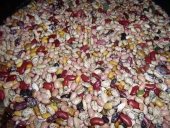Jesse Roberts wrote:What are your favorite pulse crops and what makes them important for growers, families, or for the local market?
My favorite pulse crop is shelling peas... I sit in the garden for hours every year. Shelling them and eating them on the spot. I can't walk past a pea patch without eating a few... Mmm. Mmm. Mmm. I allow a lot of different kinds of peas to go to seed, and eat them as dry peas added to soups, or sprouted peas added to salads or stir-fries. Shelling peas are the highest priced pulse at my local market. I suppose that's due to the fabulous taste, and to the high labor cost of picking them. Also, this area used to support a canning factory, and peas were one of the major crops. Therefore I expect that there is a community meme of loving good shelling peas.
Shelling Peas:
I also eat garbanzo beans fresh from the garden. They have fewer peas per pod, so not as enticing. I normally let them go to dry seeds. They are not popular here. Yields tend to be low.
Garbanzo Beans:
My other cold weather beans are fava beans. I typically eat them as dry beans cooked into a soup. They are the hardest for me to grow... But would do well here in a year without a summer. They really don't do well in hot summer weather, which is typical here, so growing them is problematic, and the community therefore doesn't know much about cooking them.
Fava Beans:
My hot weather beans are common beans, teparies, cowpeas, and runner beans. I eat all of them as bean soup, refried beans, or as cooked sprouts either in soups, salads, casseroles, or stir-fries. Additionally, I eat the runner beans as shellies, cooked fresh from the almost mature still-wet pods. I don't eat any of these raw, because I am put-off by the taste of their poisons. I don't typically eat them as green beans, because the nutrient profile is so low. Tepary pods are particularly poisonous tasting! Runner bean pods are coarse. Cowpea pods must be an acquired taste that people around here haven't bothered to acquire. If you want to see a disgusted look on a communitie's face, come to my farmer's market and give away samples of cooked cowpea pods!!!
Common beans:
Tepary Beans:
Runner Beans:
Cowpeas:
This year, I am also growing experimental crops of lima bean, soybeans, and lentils. I figure that my garden is more reliable if I grow a number of different type of pulses. I called runner beans a hot-weather bean, but they tend to thrive better in summers that are a bit cooler and wetter than typical for this area. I think of them as a hedge against the El Nino weather pattern.
And some of them are really pretty!
Runner Bean flowers:
Crimson-flowered fava:










